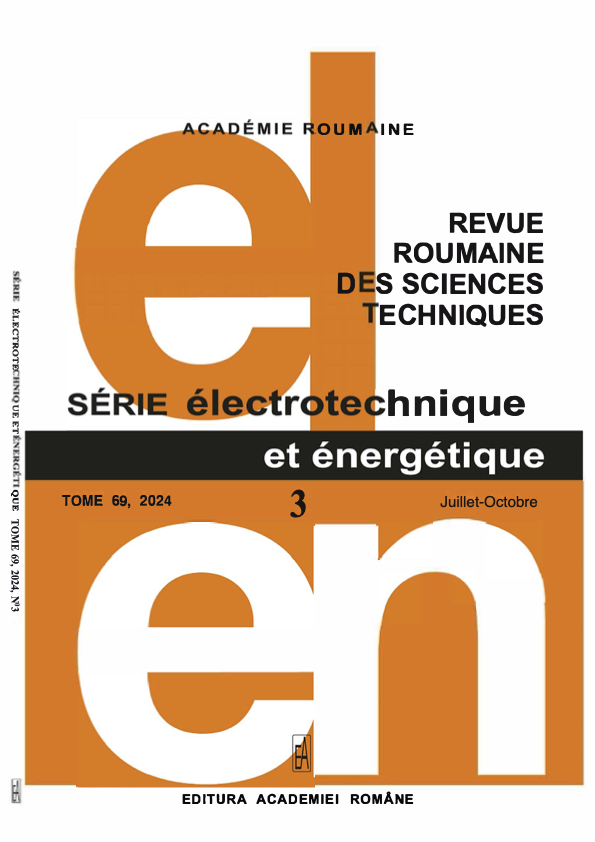A RANDOMIZED CARRIER-BASED DISCONTINUOUS PULSE WIDTH MODULATION STRATEGY FOR NEUTRAL POINT CLAMPED THREE-LEVEL INVERTER
DOI:
https://doi.org/10.59277/RRST-EE.2024.69.3.13Keywords:
Random pulse width modulation (PWM), Discontinuous PWM, Switching losses, Three-level inverter, Electromagnetic compatibility (EMC)Abstract
This article introduces a novel approach called randomized carrier-based discontinuous pulse width modulation (RCDPWM) to address the challenge of mitigating both low-order and high-order harmonics concentrated at the switching frequency and its integer multiples in the output voltage and current of a three-level inverter. The proposed strategy reduces switching losses and a wide dispersion of voltage and current harmonics with significantly smaller amplitudes by integrating features from discontinuous and randomized PWM methods. This characteristic proves beneficial for enhancing efficiency and electromagnetic compatibility. The RCDPWM strategy involves three schemes: two simple schemes (one random parameter), randomized pulse position modulation (RPP-DPWM) and randomized carrier frequency modulation (RCF-DPWM), and a dual scheme combining the two previous ones (RPPRCF-DPWM). Power spectral density (PSD) is used to assess the effectiveness of the proposed strategy in quantitatively analyzing the harmonic dispersion degree. The results demonstrate that the proposed RCDPWM strategy significantly expands harmonic clusters around the switching frequency, reducing its intensity. The spectrum analysis revealed that the RPPRCF-DPWM scheme is the most effective in spreading the output voltage and current spectrum compared to simple schemes (RPP-DPWM and RCF-DPWM).
References
(1) Aimad Boudouda, Dual randomized discontinuous pulse width modulation for three-phase inverter, International Journal of Electronics, 111, 9 (2023).
(2) A. Boudouda, Boudjerda N., Aibeche A., dSPACE-based dual randomized pulse width modulation for acoustic noise mitigation in an induction motor, Journal of the Brazilian Society of Mechanical Sciences and Engineering, 44, 493, pp. 1–16 (2022).
(3) P.K. Chaturvedi, I.S. Jain, P. Agarwal. Reduced switching loss pulse width modulation technique for three-level diode clamped inverter, IET Power Electron., 4, 4, pp. 393–399 (2011).
(4) Y. Shrivastava, S.Y. Hui, Analysis of random PWM switching methods for three-level power inverters, IEEE Transactions on Power Electronics, 14, 6, 1156–1163 (1999).
(5) A.M. Hava, R.J. Kerkman, T.A. Lipo, A high-performance generalized discontinuous PWM algorithm, IEEE Transactions on Industry Applications, 34, 5, pp. 1059–1071(1998).
(6) O. Ojo, The generalized discontinuous PWM scheme for three-phase voltage source inverters, IEEE Transactions on Industrial Electronics, 51, 6, pp. 1280–1289 (2004).
(7) M. Paramasivan, M.M. Paulraj, S. Balasubramanian, Assorted carrier-variable frequency-random PWM scheme for voltage source inverter, IET Power Electronics, 10, 14 (2017).
(8) P. Lezynski, Random modulation in inverters with respect to electromagnetic compatibility and power quality, IEEE Journal of Emerging and Selected Topics in Power Electronics, 6, 2, pp. 782–790 (2018).
(9) Z. Zhang, L. Wei, P. Yi, Y. Cui, P.S. Murthy, A.M. Bazzi, Conducted emissions suppression of active front end (AFE) drive based on random switching frequency PWM, IEEE Transactions on Industry Applications, 56 6, pp. 6598–6607 (2020).
(10) C.H. Moon, C.J. Chen, S.W. Lee, A random modulation spread-spectrum digital PWM for a low system clock digital buck converter, IEEE., 9, (2021).
(11) N. Boudjerda, A. Boudouda, M. Melit, B. Nekhoul, K. El Khamlichi Drissi, K. Kerroum, Spread spectrum in three-phase inverter by an optimised dual randomised PWM technique. International Journal of Electronics, 101, 3, pp. 308–324 (2014).
(12) A. Boudouda, N. Boudjerda, A. Aibeche, A. Bouzida, Dual randomized pulse width modulation technique for buck converter fed by photovoltaic source. Rev. Roum. Sci. Techn. – Électrotechn. et Énerg, 63, 3, pp. 289–294 (2018).
(13) A. Boudouda, N. Boudjerda, K. El Khamlichi Drissi, K. Kerroum, Combined random space vector modulation for a variable speed drive using induction motor, Electrical Engineering, 98, 1, pp. 1–15 (2016).
(14) A. Boudouda, A. Bouzida, F. Nafa. Spectral analysis of switch voltage for dual randomized PWM DC-DC converters operating in DCM, International Journal of Electronics Letters, 10, 1, 101–114 (2022)
(15) K.S. Kim, Y.G. Jung, Y.C. Lim, A new hybrid random PWM scheme. IEEE Transactions on Power Electronics, 24, 1, 1 pp. 92-200 (2009)
(16) F. Bu, T. Pu, W. Huang, L. Zhu, Performance and evaluation of five-phase dual random SVPWM strategy with optimized probability density function, IEEE Transactions on Industrial Electronics, 66, 5, pp. 3323–3332 (2019).
(17) Y. Huang, Y. Xu, W. Zhang, J. Zou, Hybrid RPWM technique based on modified SVPWM to reduce the PWM acoustic noise. IEEE Transactions on Power Electronics, 34, 6, pp. 5667–5674 (2019).
(18) Y. Li, H. Wu, Q. Si, Y. Liu, Vibration noise suppression approach based on random switching frequency control for permanent magnet motor, Transactions of the Canadian Society for Mechanical Engineering, 45, 3, pp. 444–460 (2021).
(19) A.M. Trzynadlowski, R.L. Kirlin, S.F. Legowski, Space vector PWM technique with minimum switching losses and a variable pulse rate [for VSI]. IEEE Transactions on Industrial Electronics, 44, 2, pp. 173–181 (1997).
(20) H. Khan, E.H. Miliani, K.E.K. Drissi, Discontinuous random space vector modulation for electric drives: a digital approach. IEEE Transactions on Power Electronics, 27, 12, pp. 4944–4951 (2012).
(21) S. Bhattacharya, D. Mascarella, G. Joos, G. Moschopoulos, Reduced switching random PWM technique for two-level inverters, IEEE Energy Conversion Congress and Exposition (ECCE) (2015).
(22) 22. Z. Zhang, L. Wei, P. Yi, P.S. Murthy, Y. Cui, Optimized digital implementation of carrier-based randomized discontinuous PWM technique for active front end (AFE) drives. IEEE Energy Conversion Congress and Exposition (ECCE) (2019).
(23) 23. Aimad Boudouda, Power spectral density of dual randomized discontinuous pulse width modulation, Rev. Roum. Sci. Techn.– Électrotechn. et Énerg, 68, 2, pp. 132–138 (2023).
(24) 24 T.S. Kiran, K. N. Pavithran, Novel approach for harmonic reduction with random PWM technique for multilevel inverters, International Conference on Power, Instrumentation, Control and Computing (PICC) (2015).
(25) P. Welch, The use of fast Fourier transform for the estimation of power spectra: A method based on time averaging over short, modified periodograms, IEEE Transactions on Audio and Electroacoustics, 15, 2, pp. 70–73 (1967).
(26) 26 ***Matlab. Signal Processing Toolbox User’s Guide, The MathWorks. Inc., Natick, MA (2004).
Downloads
Published
Issue
Section
License
Copyright (c) 2024 REVUE ROUMAINE DES SCIENCES TECHNIQUES — SÉRIE ÉLECTROTECHNIQUE ET ÉNERGÉTIQUE

This work is licensed under a Creative Commons Attribution-NonCommercial-NoDerivatives 4.0 International License.


